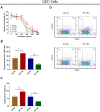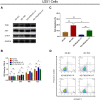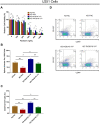Tenascin C Promotes Glioma Cell Malignant Behavior and Inhibits Chemosensitivity to Paclitaxel via Activation of the PI3K/AKT Signaling Pathway
- PMID: 33876384
- PMCID: PMC8349315
- DOI: 10.1007/s12031-021-01832-8
Tenascin C Promotes Glioma Cell Malignant Behavior and Inhibits Chemosensitivity to Paclitaxel via Activation of the PI3K/AKT Signaling Pathway
Abstract
The present study aimed to detect the effect of tenascin C (TNC) on cell function and chemosensitivity to paclitaxel and phosphatidylinositol 3-kinase/protein kinase B (PI3K/AKT) signaling in glioma cells.Human glioma cells U87, LN-229, T98G and U251 and normal human astrocytes were obtained, in which TNC expression was detected. The U87 cells and U251 cells were chosen and infected with lentivirus of control overexpression, TNC overexpression, control knockdown, and TNC knockdown for functional experiments. Rescue experiments were then performed to evaluate the effect of PI3K/AKT activator 740 Y-P on cell function and chemosensitivity to paclitaxel in TNC knockdown U251 cells. TNC mRNA and protein expression was elevated in glioma cells, including U87, LN-229, U251 and T98G cells, compared to normal human astrocytes. In U87 and U251 cells, TNC promoted proliferation while inhibiting apoptosis. In addition, TNC upregulated PI3K and p-AKT protein expression in U87 and U251 cells. As for chemosensitivity, TNC increased relative viability in U251 cells treated with 400 ng/mL and 800 ng/mL paclitaxel. In terms of stemness, TNC increased the sphere number per 1000 cells, CD44+CD133+ cell percentage and 1/stem cell frequency (assessed by extreme limiting dilution analysis) in U251 cells. In rescue experiments, 740 Y-P reduced the effect of TNC on proliferation, apoptosis, chemosensitivity to paclitaxel, and stemness in U251 cells. TNC acts as an oncogenic factor by promoting cancer cell proliferation and stemness while inhibiting apoptosis and chemosensitivity to paclitaxel in glioma via modulation of PI3K/AKT signaling.
Keywords: Cell function; Chemosensitivity; Glioma; PI3K/AKT signaling; Tenascin C.
© 2021. The Author(s).
Conflict of interest statement
The authors declare no potential conflicts of interest with respect to the research, authorship and/or publication of this article.
Figures







Similar articles
-
Neuroglobin promotes the proliferation and suppresses the apoptosis of glioma cells by activating the PI3K/AKT pathway.Mol Med Rep. 2018 Feb;17(2):2757-2763. doi: 10.3892/mmr.2017.8132. Epub 2017 Nov 22. Mol Med Rep. 2018. PMID: 29207186
-
Effects of Fibronectin 1 on Cell Proliferation, Senescence and Apoptosis of Human Glioma Cells Through the PI3K/AKT Signaling Pathway.Cell Physiol Biochem. 2018;48(3):1382-1396. doi: 10.1159/000492096. Epub 2018 Jul 26. Cell Physiol Biochem. 2018. Retraction in: Cell Physiol Biochem. 2020;54(6):1257. doi: 10.33594/000000317. PMID: 30048971 Retracted.
-
Silencing of Tenascin-C Inhibited Inflammation and Apoptosis Via PI3K/Akt/NF-κB Signaling Pathway in Subarachnoid Hemorrhage Cell Model.J Stroke Cerebrovasc Dis. 2020 Jan;29(1):104485. doi: 10.1016/j.jstrokecerebrovasdis.2019.104485. Epub 2019 Nov 6. J Stroke Cerebrovasc Dis. 2020. PMID: 31706751
-
Tenascin-C Function in Glioma: Immunomodulation and Beyond.Adv Exp Med Biol. 2020;1272:149-172. doi: 10.1007/978-3-030-48457-6_9. Adv Exp Med Biol. 2020. PMID: 32845507 Review.
-
Matricellular protein tenascin C: Implications in glioma progression, gliomagenesis, and treatment.Front Oncol. 2022 Aug 12;12:971462. doi: 10.3389/fonc.2022.971462. eCollection 2022. Front Oncol. 2022. PMID: 36033448 Free PMC article. Review.
Cited by
-
Microrchidia family CW‑type zinc finger 2 promotes the proliferation, invasion, migration and epithelial‑mesenchymal transition of glioma by regulating PTEN/PI3K/AKT signaling via binding to N‑myc downstream regulated gene 1 promoter.Int J Mol Med. 2022 Feb;49(2):16. doi: 10.3892/ijmm.2021.5071. Epub 2021 Dec 16. Int J Mol Med. 2022. PMID: 34913078 Free PMC article.
-
Extracellular Vesicles Carrying Tenascin-C are Clinical Biomarkers and Improve Tumor-Derived DNA Analysis in Glioblastoma Patients.ACS Nano. 2025 Mar 18;19(10):9844-9859. doi: 10.1021/acsnano.4c13599. Epub 2025 Mar 8. ACS Nano. 2025. PMID: 40056466 Free PMC article.
-
Bufotalin enhances apoptosis and TMZ chemosensitivity of glioblastoma cells by promoting mitochondrial dysfunction via AKT signaling pathway.Aging (Albany NY). 2024 May 28;16(10):9264-9279. doi: 10.18632/aging.205883. Epub 2024 May 28. Aging (Albany NY). 2024. PMID: 38809514 Free PMC article.
-
Evaluating nanoparticle localisation in glioblastoma multicellular tumour spheroids by surface enhanced Raman scattering.Analyst. 2023 Jul 10;148(14):3247-3256. doi: 10.1039/d3an00751k. Analyst. 2023. PMID: 37366648 Free PMC article.
-
The complex interactions between the cellular and non-cellular components of the brain tumor microenvironmental landscape and their therapeutic implications.Front Oncol. 2022 Oct 6;12:1005069. doi: 10.3389/fonc.2022.1005069. eCollection 2022. Front Oncol. 2022. PMID: 36276147 Free PMC article. Review.
References
-
- Bell EH, Zhang P, Shaw EG, Buckner JC, Barger GR, Bullard DE, Mehta MP, Gilbert MR, Brown PD, Stelzer KJ, McElroy JP, Fleming JL, Timmers CD, Becker AP, Salavaggione AL, Liu Z, Aldape K, Brachman DG, Gertler SZ, Murtha AD, Schultz CJ, Johnson D, Laack NN, Hunter GK, Crocker IR, Won M, Chakravarti A. Comprehensive Genomic Analysis in NRG Oncology/RTOG 9802: A Phase III Trial of Radiation Versus Radiation Plus Procarbazine, Lomustine (CCNU), and Vincristine in High-Risk Low-Grade Glioma. J Clin Oncol. 2020;38(29):3407–3417. doi: 10.1200/JCO.19.02983. - DOI - PMC - PubMed
-
- Buckner J, Pugh S, Shaw E, Gilbert M, Barger G, Coons S, Ricci P, Bullard D, Brown P, Stelzer K, Brachman D, Suh J, Schultz C, Bahary J-P, Fisher B, Kim H, Murtha A, Curran W, Mehta M. Phase III study of radiation therapy (RT) with or without procarbazine, CCNU, and vincristine (PCV) in low-grade glioma: RTOG 9802 with Alliance, ECOG, and SWOG. J Clin Oncol. 2014;32:2000–2000. doi: 10.1200/jco.2014.32.15_suppl.2000. - DOI
MeSH terms
Substances
LinkOut - more resources
Full Text Sources
Other Literature Sources
Medical
Research Materials
Miscellaneous

